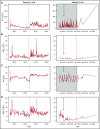Bone marrow failure unresponsive to bone marrow transplant is caused by mutations in thrombopoietin
- PMID: 28559357
- PMCID: PMC5561901
- DOI: 10.1182/blood-2017-02-768036
Bone marrow failure unresponsive to bone marrow transplant is caused by mutations in thrombopoietin
Abstract
We report 5 individuals in 3 unrelated families with severe thrombocytopenia progressing to trilineage bone marrow failure (BMF). Four of the children received hematopoietic stem cell transplants and all showed poor graft function with persistent severe cytopenias even after repeated transplants with different donors. Exome and targeted sequencing identified mutations in the gene encoding thrombopoietin (THPO): THPO R99W, homozygous in affected children in 2 families, and THPO R157X, homozygous in the affected child in the third family. Both mutations result in a lack of THPO in the patients' serum. For the 2 surviving patients, improvement in trilineage hematopoiesis was achieved following treatment with a THPO receptor agonist. These studies demonstrate that biallelic loss-of-function mutations in THPO cause BMF, which is unresponsive to transplant due to a hematopoietic cell-extrinsic mechanism. These studies provide further support for the critical role of the MPL-THPO pathway in hematopoiesis and highlight the importance of accurate genetic diagnosis to inform treatment decisions for BMF.
© 2017 by The American Society of Hematology.
Conflict of interest statement
Conflict-of-interest disclosure: The authors declare no competing financial interests.
Figures


Comment in
-
Inherited thrombocytopenia and Occam's razor.Blood. 2017 Aug 17;130(7):839-840. doi: 10.1182/blood-2017-06-789131. Blood. 2017. PMID: 28818975 No abstract available.
References
-
- Krissinel E, Henrick K. Secondary-structure matching (SSM), a new tool for fast protein structure alignment in three dimensions. Acta Crystallogr Sect D Biol Crystallogr. 2004;60(Pt 12 Pt 1):2256-2268. - PubMed
-
- The PyMOL Molecular Graphics System, Version 1.8. Schrodinger LLC; 2015.
Publication types
MeSH terms
Substances
Grants and funding
LinkOut - more resources
Full Text Sources
Other Literature Sources
Medical
Molecular Biology Databases

